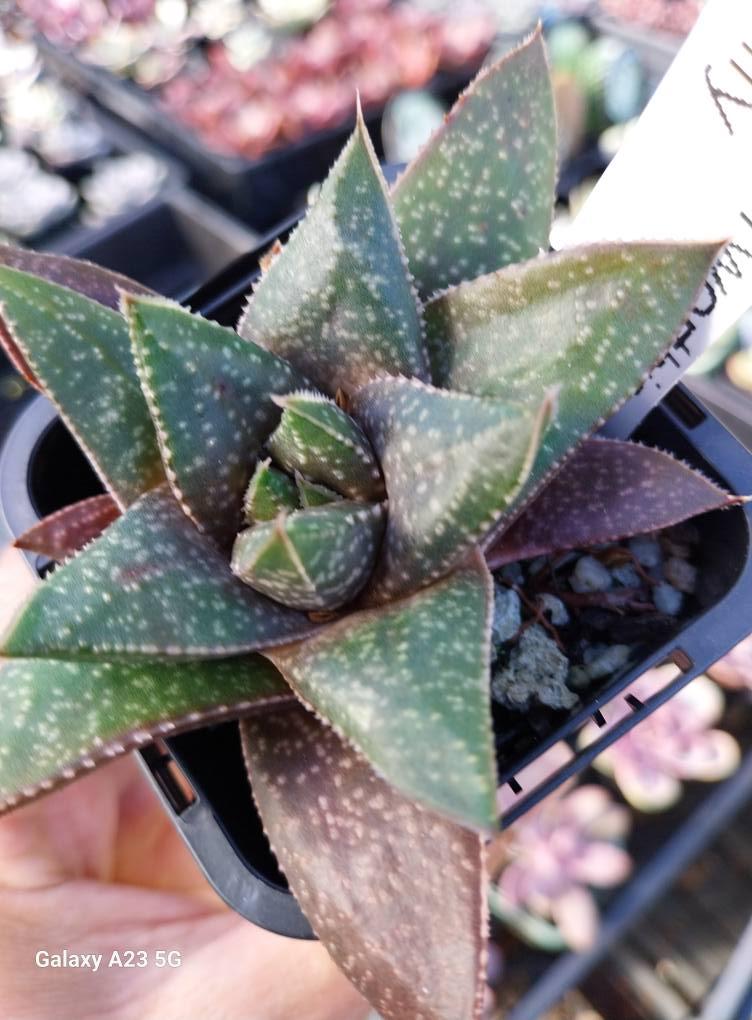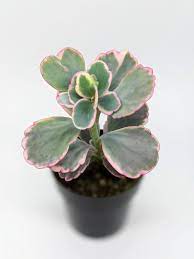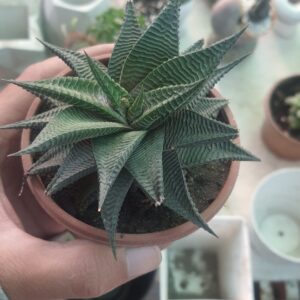A Hybrid Succulent Gem – Gasterhaworthia ‘Golly’
The hybrid succulent Gasterhaworthia ‘Golly’ is a lovely and distinctive cross between Haworthia and Gasteria species. This combination produces a plant with the textured, nodular leaves of Haworthia and the thicker, lustrous leaves of Gasteria, which frequently have a dark green color with light green, white, or translucent dots and streaks.
Gasterhaworthia “Golly” is ideal for windowsills, tables, terrariums, and little plant collections since it is compact, hardy, and requires little maintenance. It grows well in mild climates both indoors and outdoors.
Overview of the Plant Kingdom
Scientific Name: Gasterhaworthia ‘Golly’
Family: Asphodelaceae
Parentage: Cross between Haworthia and Gasteria
Typical Names: Golly, Gasterhaworthia hybrid
Growth Pattern: Succulent that forms rosettes
Size:
Height: 4–6 inches (10–15 cm)
Spread: between 6 and 8 inches (15–20 cm)
Look
Leaves:
Triangular to lance-shaped, short, and thick
Intense green with notable white spots, bands, or translucent motifs
Solid to the touch, with a little sheen
Frequently develops as a cluster of rosettes in a spiral form.
Flowers:
Usually in pinkish or orange tones, it blooms with little tubular flowers on thin, arching flower stalks.
Spring to summer blooming
☀️ Needs for Light
Inside:
Likes indirect, intense light
Does well close to windows facing east or west
May withstand lower light, but thrives when exposed to bright light for at least 4–6 hours every day
Outside:
It thrives in a setting with filtered sunshine and partial shade.
To prevent leaf scorch, shield from the midday heat.
The leaf markings and color intensity are enhanced by the bright yet filtered light.
Humidity and Temperature
Temperature:
Optimum temperature range is 18-27°C (65–80°F).
Keep out of temperatures under 10°C (50°F).
Not resistant to frost; bring inside during chilly conditions
Humidity:
Likes humidity levels between low and mild.
If there is too much humidity and not enough ventilation, rot can occur.
💧 Watering regimen
from spring to fall (active growth):
Water if the top 1–2 inches of soil are dry
Usually every 10 to 14 days, but changes according to temperature, light, and container size
Employ the soak and dry technique, which involves watering the soil thoroughly and letting it dry out completely before the next application.
Winter (Dormancy):
Water less often, around once every three to four weeks.
Water sparingly to keep it from drying out completely.
Do not let water collect in the leaf rosettes since this will cause rot.
Needs for the Soil
Kind:
Demands gritty soil that drains well
Suggested combination:
50% soil for growing succulents and cacti
25% pumice or perlite
coarse sand accounts for 25% of the total.
pH: Between neutral and somewhat acidic (6.0-7.0)
Make sure the pots you use always have enough drainage holes.
Fertilizing
Apply fertilizer during the growth period (spring and summer):
Use a cactus/succulent fertilizer that is diluted and balanced (half strength)
Feed once a month
In winter, no fertilization is necessary.
Excessive fertilization might result in leggy, stunted development.
Pruning and maintenance
Simple upkeep
Remove:
Dead, dried, or broken leaves at the bottom
Spent flower stalks after blooming
For improved photosynthesis, clean the leaves once in a while to get rid of dust.
🌿 Reproduction
Offsets (Pups):
At the base, it forms offsets or “pups.”
Once they are large enough to have a few roots, carefully remove the pups.
Before replanting, allow offsets to callous over for a day or two.
Leaf Cutting:
Less common, albeit feasible, but takes longer to establish.
Rarely grown by seed in residential environments.
🛡️ Typical Issues
Excessive irrigation: Mushy leaves and root rot
Underwatering: The leaves could become thin or wrinkled.
Pests: Occasionally affected by:
Mealybugs
Spider mites
Scale bugs
Intense, direct sun exposure leads to sunburn, which manifests as translucent or brown patches.
Regular inspections and the use of neem oil or insecticidal soap may help to prevent pest problems.
Warning: Toxicity
Although it’s usually not harmful to people and animals, it’s still recommended to keep it away from pets that could bite on it.
🎍 Aesthetic Use
Perfect for:
arrangements that are luscious
Terrariums
Plants for desktops
rock gardens
Bright indoor locations for potted displays
It is a favorite among succulent collectors due to its small size, distinctive markings, and low maintenance requirements.
✅ The conclusion
For those looking for a low-maintenance, ornamental plant, the beautiful and simple-to-care-for hybrid succulent Gasterhaworthia ‘Golly’ is a great option. With sufficient sunlight, correct watering, and adequate soil drainage, ‘Golly’ will flourish and even spread over time.
Office Plants, Succulents
Gasterhaworthia Golly
₨749.00
Gasterhaworthia Golly
A hybrid succulent blending the charm of Gasteria and Haworthia—textured, compact, and distinctly ornamental.





Reviews
There are no reviews yet.